
Welcome to the Harrow County Observer, Multiversity Comics’ dedicated “Harrow County” column. Regular readers will know the latest arc, ‘Done Come Back,’ is also the final arc for the series, so we’re doing something a little different. Instead of talking about the arc after it’s finished, we’re discussing each issue as it comes out. This month writer Cullen Bunn, artist Tyler Crook, and editor Daniel Chabon join us to discuss “Harrow County” #31. Obviously, major spoilers ahead if you haven’t read it yet!
If you’ve missed the previous instalments, here’s Part 1 and here’s Part 2.

In the last Harrow County Observer, we talked about the colors in issue #30, and how the greens in particular demonstrated a proximity to Hester Beck. In issue #31, the color choices stand out even more—most pages are soaked in gray and black. After thirty issues of color, #31 feels so terribly wrong just from a glance at the page. It feels desolate.
Daniel Chabon: The color choices in this issue certainly add to the mood of where the story has been going. I anticipate the next issue will be completely black. 😬
Tyler Crook: Haha. Yeah, I got really excited about draining all the color out of this issue. It makes her visions later glow in a way that I’m really happy with.
Cullen Bunn: There’s something rotten in Harrow! I think this sequence really shows that this is not “business as usual” for Emmy. She’s heading toward her darkest moments.
Tyler: In the script I think you just said that she was supposed to be in the woods. But I thought more specifically it should be in a deep dark ravine to reflect how Emmy’s feeling at that moment.

Of course, there’s a big color callback to a scene from issue #2, with the figures that appear to Emmy in the woods. It seems rather circular this element should reappear in the penultimate issue.
Cullen: I can’t fully explain how much I love those bright colors and how much that helps to define the look and feel of this series.

Tyler: I love those day-glow scenes. Visually, I think the ones in #31 work the same as the flaming skeletons. You can just plop them in the middle of any night scene and the whole page seems to come alive.
Some of my favorite moments in this series have been characters wandering through the woods at night with something terrible out there—I remember it as one of the things that really grabbed me about #2—and this issue took that sort of material and turned it up to maximum. For me at least, it felt like it’s really celebrating what makes “Harrow County” the book that it is.
Tyler: I was just pointing out to Cullen that the last time we saw the sun in “Harrow County” was issue #25. This has been one hell of a night!
Cullen: I think a lot of this issue (and this arc) is a call-back to the “most Harrow” elements of “Harrow County.” It’s absolutely a fond farewell to this story.
Daniel: I’m never going camping in the woods again.

We’re going to take a look at how a sequence develops—pages 16 to 20 of issue #31. So before the script, how much had you discussed this moment? Considering this is so close to the end, was it something that’d been brewing in your heads for a long time?
Cullen: I called Tyler and spoke to him about this sequence. It was not a moment that we had planned, but it is still something that we’d been building to. It’s a culmination of sorts. If readers weren’t aware that the series was drawing to a close, this scene would tell them in no uncertain terms. Everything that’s happened up until this point comes tumbling back into Emmy’s life.
Tyler: Like Cullen said, these specific events weren’t really planned, but we knew we’d need a scene like this. We did have to have a conversation when I got the script about how Emmy’s vision should be represented visually. There is a loose logic around how this stuff works and I feel like tying it back to Emmy’s dreams from the first few issues made a lot of sense.
Continued belowDaniel, what’s your part during these early pre-script stages?
Daniel: Back in 2016, I think when we were working on issue #15, Cullen sent me a plot breakdown for every issue up to #32. At that point I didn’t realize Cullen and Tyler intended to end the series that early—I guess in my head I always thought we’d go for fifty issues. When that got turned in I saw a much more natural ending for the series. The story seemed to fit better at thirty-two rather than be stretched out further. I don’t remember specifically what my notes were for the outline at the time, and some subtle things had been changed in the story since, but I always try to make sure the story makes sense in what’s being pitched.
Cullen: His part is messaging me constantly for script. He’s like the old tree, spewing flame and crying out into the night, only instead of “Lies! Lies! Lies!” He’s screaming “Script! Script! Script!”
Just kidding Daniel.
Sorta.
Daniel: Mark, can I post Cullen’s due dates in this interview?
Sorry, I have other interviews with Cullen. I gotta stay on his good side.

Let’s jump ahead to the script phase. Here’s Cullen’s script for pages 16 to 20 of the final comic (labeled as 15 to 19 here due to the double-page spread at the beginning being scripted as simply page 1).



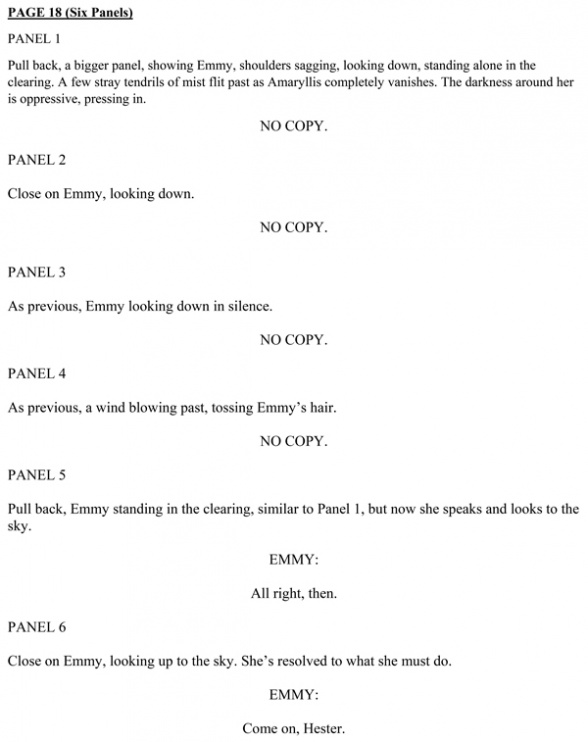

Part of the reason I picked this sequence was because it switches tone significantly throughout. At the beginning it’s especially dialogue heavy, then transitions to long sections of silence. Cullen, how do you tackle scripting largely silent sequences? And do you approach a script that you know Tyler’s drawing differently in any way?
Cullen: For me, choosing dialogue heavy sections versus silent sections is largely about the rhythm of the story. In this case, I felt the moment when Emmy takes flight needed to be silent anyway, to give it some weight and intensity. Her single line of dialogue, followed by a heavy silence puts some emphasis on those words as well as Emmy’s decision in that moment. Knowing those panels would be silent, I wanted the preceding pages to have a little more dialogue. It’s all about peaks and valleys.
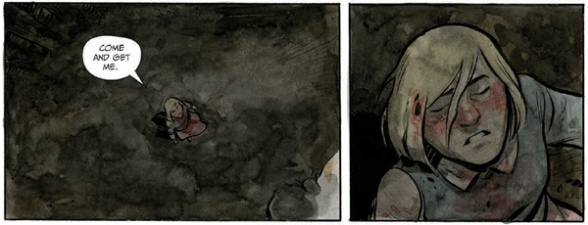
The way you’ve written Amaryllis, you’ve put so much of an emphasis on her physicality, how she stands, what her body language is. A tilt of her head is given as much importance as a line of dialogue.
Cullen: Sometimes, little gestures like the tilting of a character’s head, can change the tone of a scene entirely. I write things like that into my scripts frequently, but it all hinges on Tyler bringing it to life.
Tyler: I friggin’ love Amaryllis. She hasn’t appeared that much but when she does, I think she really steals the show. When I’m drawing her I’m always trying to channel my mom and all my cool aunts. They have this way of letting you know that they love you even when they are telling you that you’re grounded for the rest of your life.
Daniel, after you’ve been messaging “Script! Script! Script!” and the script finally comes in, what are you looking for in it?
Daniel: At this stage it’s really been more looking for typos and any major errors. This far into the series Cullen and Tyler have established a natural rhythm to the storytelling of “Harrow County” so it hasn’t really justified any major changes or revisions. Just give this goblin a beard and that ghost a soul patch—that sort of thing. Important stuff.
Which brings us to man draw goblin beards and ghost soul patches. Tyler, when you get the script, what’s your process of getting it to layouts?
Continued belowTyler: Cullen has been really far ahead of me for most of the series. So I’ll usually get the script and give it a quick read and then totally forget what’s in it because I still have to draw two or three issues before I can get to that particular script. So when I sit down to do layouts, I usually give it a reread. Sometimes I’ll do kind of an issue map where I diagram out how many pages each scene will be and make notes on the mood and the flow of the story.
The layout process is the hardest part of making comics, I think. I’m trying to balance a lot of different things—stuff like composition, balloon placements, character staging and acting. I’ve been doing my layouts digitally lately because it makes it easier to correct things and change my mind about stuff. It usually takes me two or three days to layout an issue. I think of it as a very detailed map of what I’m going to be doing over the next five weeks. But things always change when I start penciling. Usually the differences are subtle, but occasionally I rethink an entire page or sequence as I pencil it.
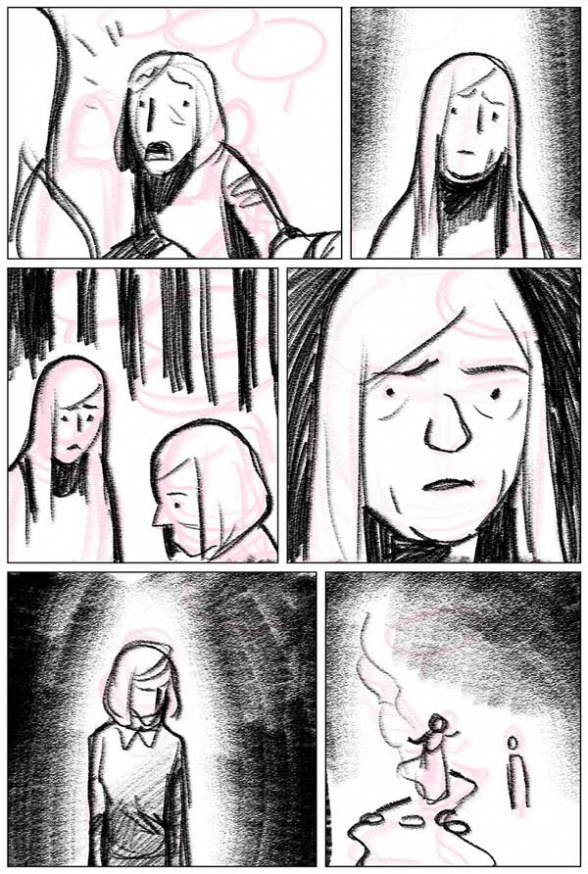
Looking at this page, I find the changes from the script interesting, such as panel 5 shifting from a close up on Emmy to a mid shot, allowing more darkness to fill the shot and for Emmy to be smaller and more vulnerable. It’s an idea pushed further in panel 6 as Amaryllis leaves.
Tyler: Yeah. Emmy is so sad and alone in that scene, I was worried that if we got too close to her we would lose that. She’s feeling the weight of the world right there and there needed to be the question of whether or not she was going to handle it. So she had to be small.
Before you move on from the layouts, these get run past Cullen and Daniel, right?
Tyler: For sure.
Cullen: Yeah, Tyler shares everything with us at every step. It’s an awesome way to see the pages come together.
Daniel: What’s nice is that Tyler usually shows us the layouts with the rough lettering on them—it enables us to make sure there’s enough room for the lettering in the final art stage. That way lettering fits into the panel OK and doesn’t cover up any characters, etc.

Tyler: One of my favorite things about making comics is trying to get the acting just right. It’s always amazing to me how the slightest change in hand position or the tilt of a head can make I put a lot of effort into finding the right pose. A lot of time gesturing to myself to see how someone would act in a given situation.
To borrow film language, as the artist you’re both actor and cinematographer in many ways. I find it fascinating the way you refine your performance through your drawings. And in some ways it’s not just what you do, but what you choose not to do. There’s a section later on (my favourite moment in this issue actually) with Emmy simply standing in silence, her head lowering a little more in each panel, with her hair obscuring more and more of her face. There’s so little happening and yet it speaks volumes.
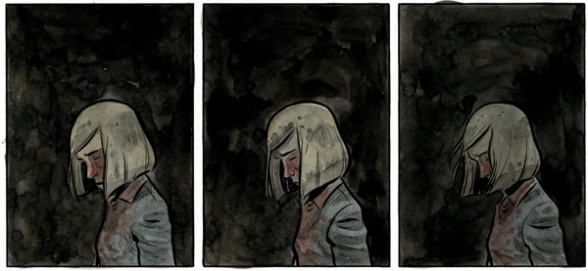
Tyler: That was for sure Cullen. He’s really good at leaving little moments like that so characters can mull things over or react to things.
Cullen: Years—oh, Lord, YEARS!—ago, my frequent collaborator Brian Hurtt (“The Damned,” “The Sixth Gun”) gave me some advice I hold dear. “It’s a comic book! Not every panel needs dialogue!” Over the years—oh, God!—I have tried to use that in various ways to control pacing or to give a single moment the weight it deserves.
Yeah, it feels grandly theatrical. Plus it was a nice touch, slightly darkening Emmy in each panel.
Continued belowTyler: Haha. Yeah, you can always go a little darker.
This sequence goes from extremes. At the beginning, with the tree, it’s much more dialogue heavy, there’s much more change from panel to panel. It’s very clear looking back that you layouts here are pulling back, doing the “less is more” thing, as the sequence progresses until that final panel when Emmy is a tiny black silhouette against a green sky. Do you find it a challenge with something like that, with a steady build over many pages?
Tyler: Sometimes it’s hard to manage slow changes. In this particular instance, it wasn’t too hard because it was very clear in my head how it was going to desaturate and get darker.
I have to talk about your lettering. You always use asymmetrical balloons, which I love, because I find they have so much more expressive potential. But then you have something like the tree, where you can just go nuts with it. Tell me about how you found the look for the tree’s dialogue.
Tyler: That part is super fun. For the tree I’m hand lettering in Photoshop. So I copy the dialogue onto the page as a font and then on a new layer I hand draw the letters using the font a loose guide. I wanted it to “sound” like the tree’s vocal chords were made out of bark so I just make all the letters looks inconsistent, chunky, and weird. There is a panel in this issue where the voice transitions from someone else to the tree voice. For that I just combined some of the font with the hand lettering.
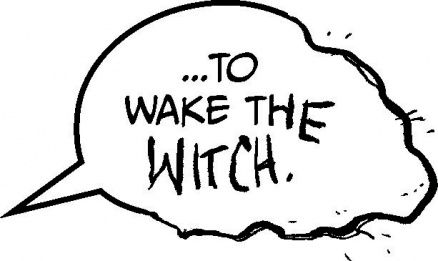
So, the next issue is the last! And it’s super-sized too. How are you handling that final sprint to the finish line?
Tyler: It’s kind of funny, the last few issues have felt really good to me. I’ve learned so much over the course of this series that I don’t think I’m the same artist as I was when I started. I don’t know if a casual reader will be able to tell the difference, but I sure can. My big worry right now is just getting it done on time to go to print. At the same time, I’m pretty sad to be leaving “Harrow County.” I really love working on this book and I love where we are leaving it.
Before we go, I just wanted to link this video of Tyler Crook’s process on “Harrow County” #31’s cover. (Check out more on his YouTube channel.)
The final issue of “Harrow County” comes out June 27, 2018.

Writer: Cullen Bunn
Artist: Tyler CrookThis is it! The final issue of Harrow County! Emmy, with the help of Bernice and the Abandoned, takes on Hester Beck in a war of magic as the hit series comes to a final conclusion.







